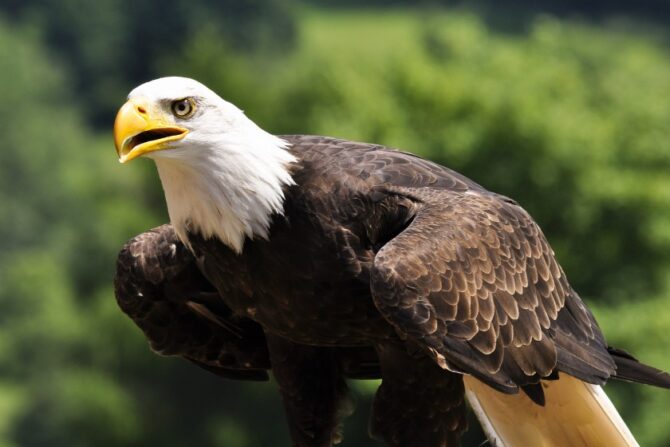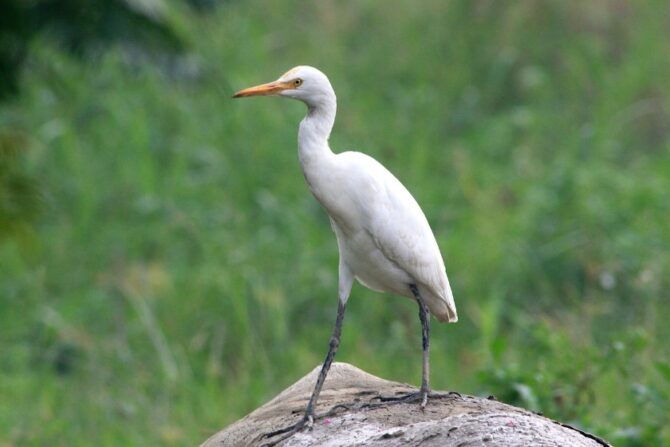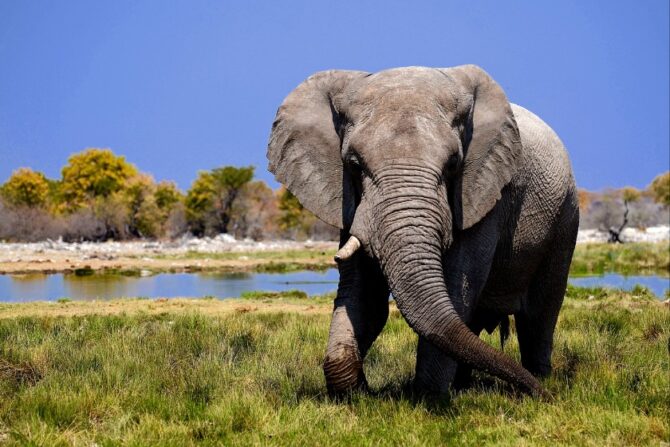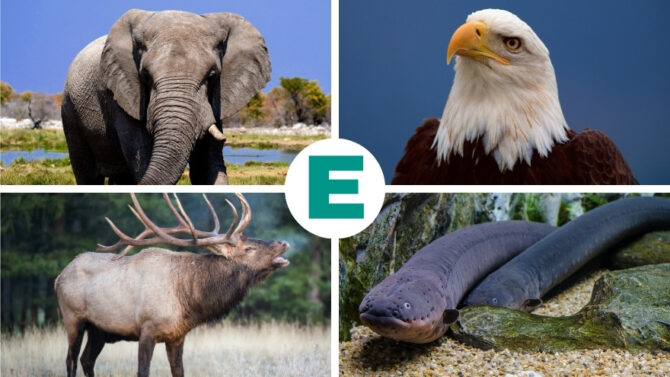Welcome to a fascinating journey through the animal kingdom, where we explore the diversity and wonder of animals that start with E as the first letter of their name.
From the largest land animal to the tiniest insect, the animal world never fails to amaze us with its incredible adaptations and unique characteristics.
In this article, we introduce you to some of the most interesting and lesser-known E animals, including pictures and interesting facts about them.
Alphabetical List of Animals that Start with E
Eagle

From the Accipitridae family, the sharp-eyed eagle is one of the most dangerous predators in the animal kingdom and a fearsome bird species across the sky.
It has one of the sharpest sights and flies majestically in search of food.
While so many call it “the king of all birds,” the eagle isn’t the most agile flyer. Yet, its speed and sharp maneuvering are above the normal standard.
Fun Fact: Eagles have very good eyesight — at least twice that of other birds.
Eagle Ray
These are aquatic animals belonging to the Myliobatidae family, the same as stingrays.
Eagles can live for as long as 25 years and are active birds throughout their lifetime.
Their swimming technique is magnificent, but their conservation status tends to face threats every now and then.
There are some species with different conservation categories: the spotted eagle ray, the critically endangered eagle ray, the endangered Pacific eagle ray, and the vulnerable purple eagle ray.
Fun Fact: Eagle rays are like birds living majestically underwater.
Earthworm
This is a genus Lumbricus Linnaeus in the Limbricidae family. These small animals are beneficial to the growth of the soil and help plants grow healthily.
Their casting is a source of nutrients for the soil. Even so, earthworms aerate the top layer, allowing oxygen, water, and light to pass through.
As a result, the root of the plant gets the desired amount of energy it needs to grow.
Fun Fact: Earthworms are hermaphrodites, meaning they possess both male and female organs.
Eastern Coral Snake

Don’t let the beauty of the Eastern coral snake fool you; this snake is termed one of the most dangerous in the world. It is slender in size and possesses jewel-toned skin.
Eastern corals are likely to be mistaken for those nonpoisonous, nonvenomous snakes, but it’s the opposite.
Their venom is so fatal that it paralyzes the body instantly. These snakes also have bands of yellow, red, and black.
Fun Fact: This species is popular in the US for its toxic and paralytic venom.
Eastern Dobsonfly
You might have noticed a set of insect-like animals near the street lamp. These are dobsonflies; they can’t help but fly nearer to lights, catching nocturnal creatures.
While so many mistakes this animal for a fly, it actually isn’t anywhere near one.
The Eastern Dobsonfly is a large winged insect with protruding mandibles. It stings so hard when provoked and leaves a long-lasting pain in the body.
Fun Fact: Eastern dobsonflies are quite vicious when provoked.
Eastern Barred Bandicoot
These medium-sized animals cover three or four feet of ground in a single leap.
They are very good at hunting and are omnivores, which means they feed on both plants and animals.
Eastern Barred Bandicoots have brown or gray fur with three or four vertical stripes on their hindquarters.
On the distribution map, these animals live in southeastern Australia and Tasmania.
Fun Fact: Eastern barred bandicoots dig funnel-shaped holes while hunting for insects.
Eastern Bluebird
Among all bluebird species, the eastern species is the only one found in the Rockies.
With beautiful and beloved nature, these birds are considered the harbingers of spring.
You’ll find some species singing, and you can hear their sounds even as the snow is still on the ground.
Their status is of great concern, and their numbers are quite minimal compared to other bluebird species.
Fun Fact: Much like leopards, these birds attack their prey by dropping straight on them from their perches.
Eastern Chipmunks
Popular actress Elizabeth Taylor had a chipmunk and wrote a book about it. It’s safe to say that the eastern chipmunk is another popular animal across America and Europe.
It serves as the main character for popular animation series. Eastern chipmunks are little and cute, but they are the largest of all chipmunks and cuddly rodents.
Their lifespan is short, yet these chipmunks can be tamed and transformed into fairly good pets.
Fun Fact: The name “chipmunk” is formed from an Ojibwe word that means “one who descends the tree headfirst.”
Eastern Gorilla
Known as one of the greatest apes in the world, the eastern gorilla is a large, scaly animal that inhabits the deepest parts of the forest, where water flows like the ocean and trees reside.
It is a genus of gorillas and is closely related to humans. Research shows that this gorilla species, most commonly found in jungles on hills and mountaintops, tends to live, love, and learn just like humans.
Fun Fact: Eastern gorillas are the largest primates in the world.
Eastern Green Mamba
The Eastern Green Mamba is such a secretive and shy species that it rarely bites and hides underneath trees most of the time.
Although eastern green mambas aren’t as venomous compared to other species, they are still green, destructive, and deadly snakes and should be avoided by humans at all costs.
Fun Fact: The green skin color of these snakes is one of the adaptations that makes life in the tree possible.
Eastern Kingbird
This is a monochromatic bird species consisting of black, dark gray, and white.
Underneath its head is a secret that stays in the bag unless there’s a reason to let it out.
Below the feathers covering their heads is a yellow, orange, or red crown. The Eastern Kingbird only showcases this crown when necessary, especially when courting.
Fun Fact: It has a fierce personality and was once termed “the butcher king.”
Eastern Rat Snake
This is a nonpoisonous, nonvenomous snake. Its name comes from the fact that this animal feeds on rats as a diet.
Also known as the chicken snake, the eastern rat species also has a taste for chicken.
So they find these little cuties wherever they are being domesticated and are fond of devouring them.
Fun Fact: Although the Eastern rat snake is nonvenomous, it kills by constriction.
Echidna
These are tiny, spiny, ant-preying animals native to Australia and Guinea. They have long, pointed hair on their skin and are divided into two species.
The three long-beaked echidna species can be found in Guinea, while the short-beaked species are rare in Australia.
Fun Fact: Of all mammals, only Echidnas and Platypuses lay eggs.
Eclectus Parrot
These parrots are one of the most beautiful and loved species among pet owners and enthusiasts.
A rare kind of parrot, the Eclectus species is a medium-sized animal inhabiting the humid climate of the rainforest and spending its 30-year lifespan within such environments.
Unlike other birds, females are maternal, and males can choose to mate with multiple partners.
Fun Fact: Eclectus parrots squawk differently.
Edible Frog
This is a rare and different frog species mostly found in aquatic areas across Europe. It is also known as the common water frog and the green frog.
This fertile hybrid is what you get by crossing two other European frogs: the Pool Frog and the Marsh Frog.
Fun Fact: Edible frogs are fond of protecting the muddy banks.
Eel

Eels are snake-like fishes that live in the water and survive with other species. “As slippery as an eel” because this animal has a slim coating.
Although they have a snakelike appearance, they are fish and nowhere near a snake.
They are ray-finned species with the order Anguilliformes, and their name comes from the word “eel.” The most dangerous eel species is the conger eel.
Fun Fact: Eels are usually a mere four inches to 13 feet long.
Eel Catfish
These are catfish native to the swampy tropical wetlands of the Congo River basin in south-central Africa.
They are air-breathing species that must reach out of the water to survive. While they need the air on land, these animals also feed on beetles.
Their distinct characteristics include a snake-like body and a slim coat. Eel catfish serve as food for some locals.
Fun Fact: Because of the eel catfish, scientists think there might be a link between fish and lizards.
Egret

The egret is a rare wading bird that lives in fresh and saltwater environments, such as wetlands and marshes.
It inhabits several parts of the world and can be found on all continents. Egrets are long-necked-wading bird species that spend most of their time wading in shallow water, catching fish and other creatures.
They might fly at a low yet powerful speed with exceptional wingbeats.
Fun Fact: Most species tend to make loud squawks and squeals.
Egyptian Cobra Snake
Also known as the Egyptian Asp, the banded Egyptian Cobra, and the snouted Cobra, this is a long snake, reaching up to 8 feet in length along its hefty body.
The forest cobra, which is an Egyptian cobra species, is the only snake that exceeds its size in Africa and has had over 30 hatchlings.
Fun Fact: The Egyptian cobra snake is one of the largest African snake species.
Egyptian Goose
This is a type of duck that has similar traits to a goose when in the sky.
They are seldom migratory and used to be prominently present in the Nile River.
Today, the Egyptian Goose has increased in population, with many species extending across Egypt and as far away as Florida in the US. Egyptian Goose also starred in ancient Egyptian art.
Fun Fact: You’d think it was a goose flying, not knowing it was an Egyptian goose.
Egyptian Mau
The Egyptian mau is a lovely and adorable cat that is now domesticated and serves as a good companion in many homes and communities.
It inhabits several parts of Egypt and is a descendant of the African wild cat.
The Egyptian mau can be friendly, playful, chatty, graceful, and regal.
Fun Fact: The Egyptian mau cat rarely exists; only mixed breeds can be found outside Egypt.
Egyptian Vulture
These are old vulture species native to Africa, southern Asia, and southern Europe.
They inhabit arid areas with open spaces near humans and multiple food options.
Because of its high sense of smell and large appetite, this bird is known to be opportunistic, preying on almost anything from human feces to ostrich eggs.
Fun Fact: Egyptian vultures crack the shells of stolen oyster eggs using rocks and pebbles.
Eider
In the Arctic tundra and subArctic coastlines are genera of large sea ducks. Males are usually more studied and powerful.
These are fliers with incredible swimming speed underwater. They tend to snatch mollusks and other marine animals and may find some plants pleasurable.
Unlike other duck species, the eider has good diving skills and reaches deep sea levels.
Fun Fact: Eiders are sexually dimorphic — meaning there’s a clear differentiation between males and females.
Eland
These are antelope species living in Africa, and they are one of the biggest species.
Their distinct characteristics include tawny colors with black markings throughout their body.
Eland antelopes look just like other antelopes but can be identified by their horns, of which the females boast the biggest.
Fun Fact: Both male and female elands have exceptional horns.
Elephant

Elephants are large animals and giants of the animal kingdom. They are rampant across Africa and Asia.
These are somewhat brave animals with high IQs that allow them to mimic human behaviors and survive in the wild.
Elephants have characteristics distinct from their nature.
Fun Fact: Elephants are some of the smartest animals to ever exist. They have a remarkable memory and can remember individuals and places for many years.
Elk

Elks are large herbivores that feed on plants. They are, in fact, the second largest herbivores after the mouse and can be identified by their large horns, which are connected like branches.
These animals are indigenous to North America, Asia, and Eurasia.
While the North American region is only left with 4 subspecies, the Eastern and Merriam’s Easter elk subspecies are extinct.
Fun Fact: Elks can consume up to 9.1 kg of vegetation daily.
Emperor Tamarins
These are rare types of monkeys inhabiting the forests of South America.
Their name stems from the dignified mustaches on their faces that make them look like German Emperor Wilhelm II.
Fun Fact: The emperor tamarins mustache not only makes them stand out but also serves a purpose in communication with their group members.
Ermine
This is a rare weasel native to Asia, Europe, North America, Eurasia, and Oceania. Ermines are miniature animals with slender physiques and appearances.
These animals are cute and lovely, but they are also fierce and brave. Ermines are fond of taking on animals bigger than them.
They are both predators for some animals and prey for others.
Fun Fact: Their fur is luxurious and has high potential in the clothing industry.
Evening Bat
Because of how friendly the evening bat is, it has become a common sight in the United States.
This animal poses no threat to humans and is gentle, always keeping its space.
Recently, it has increased in population, and its diet consists of insects and pests.
Fun Fact: Evening bats are known for their acrobatic flight, which allows them to catch insects in mid-air with great agility.
Conclusion
The fascinating world of animals that start with E includes many remarkable creatures inhabiting our planet.
From majestic elephants and echidnas to elusive eels and agile eagles, each animal brings something special to the table — from their unique physical features, behavior, or ecological role.






